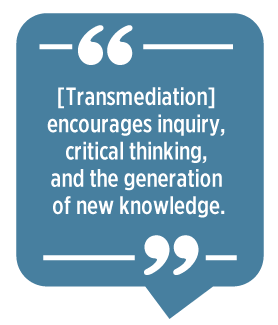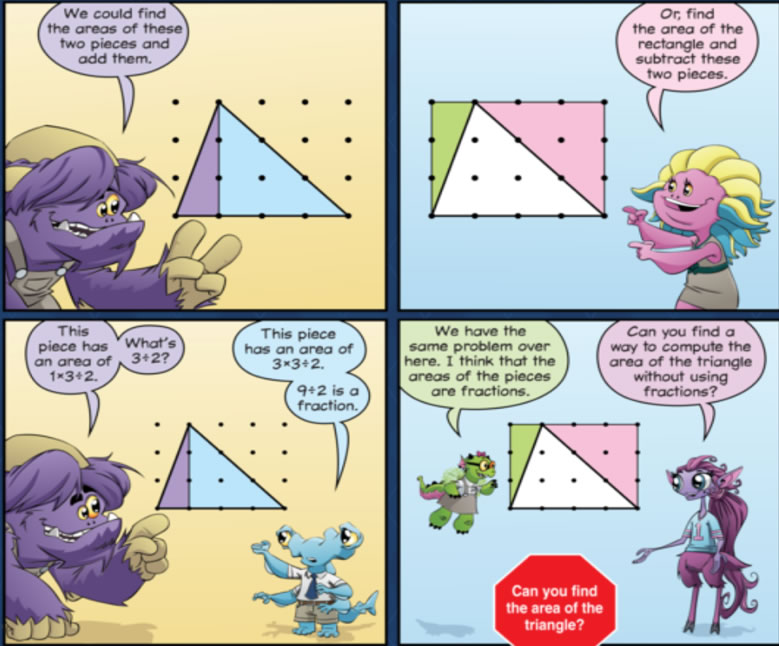|
 When students are asked to read a story, teachers often
check their understanding either through traditional Q&A or writing a
summary, which can be boring and time consuming, especially in an online class.
Transmediation eliminates boredom and allows the teacher to spot the parts that
students may have misunderstood or skipped while reading.
When students are asked to read a story, teachers often
check their understanding either through traditional Q&A or writing a
summary, which can be boring and time consuming, especially in an online class.
Transmediation eliminates boredom and allows the teacher to spot the parts that
students may have misunderstood or skipped while reading.
In this
article, we’ll learn about the benefits of transmediation in literacy and STEM
(science, technology, engineering, and math) learning and how to implement it
in online classes with a variety of apps and websites to unleash learners’
creativity while learning.
What Is Transmediation?
Transmediation is the process of
bringing meaning from one semiotic system to another; there are five semiotic
systems: the linguistic, visual, audio, gestural and spatial systems. In the
case of this article, transmediation refers to the process of taking what one
knows in language and representing it in other modalities—specifically, art—or
vice versa.
When using
multimodalities, everything from the placement of images to the organization of
the content to the method of delivery creates meaning. This is the result of a
shift from isolated text being relied on as the primary source of communication
to the image being utilized more frequently in the digital age (Lutkewitte,
2013). In her article, McCormick (2011) describes how children move from one
modality to another (e.g., linguistic to choreographic) and, because there is
no prescriptive way for the students to do this, this act itself encourages
inquiry, critical thinking, and the generation of new knowledge. This practice
of creatively shifting between modalities can be applied in online learning
using the digital storytelling technique, where students create and share their
digital stories.
Why Transmediation?
Reducing
Verbo-centrism
Verbo-centrism is the privileging of
language and meaning over other types of media. However, 21st-century students
need to express their understanding in more engaging and creative ways than by
using words only. Incorporating digital visual literacy in the curricula and
teaching practices of English language teaching to develop learners’ capacity
to critically engage with and produce images, or to assist reading, writing,
listening, and speaking skills, ought to be systematically and explicitly
integrated as an essential element of 21st-century education (Villamizar,
2018).
Encouraging Active
Learning
Students
will be in control of their learning as they use different media to express
what they have learned (drawing, video making, etc.). Because students must
choose the right media and the best technology to convert simple words into
another form, transmediation can help develop students’ critical thinking
skills and decision-making processes.
 A Tool for Assessment
of Learning A Tool for Assessment
of Learning
Teachers can
use the students’ productions to measure their literacy learning against standards (quantitively and qualitatively) by comparing what students included in their
projects to what’s been explained in the lesson. Finding gaps reflects the
students’ gaps in understanding the lesson.
Strategies for Implementing Transmediation in Online Classes
Gamification
The
incorporation of components of gaming into a course/lesson restructures
learning to be more challenging, engaging, and rewarding for learners. Using
Minecraft in coding or storytelling is an example.
Flipped
Learning
In flipped
learning, students get to learn about the lesson before the teacher explains it
in class. Transmediation can be used in this strategy when the teacher shows
the students a set of pictures/drawings and the students try to guess the story
behind them. Once guessed, they express it in writing and the teacher can
discuss their work in the following class.
Story
Conversion
Students
learn best when they’re engaged in their learning process. So, after reading a
text, the students get to express and reflect upon their understanding by using
multimedia, such as movie making, drawing, or podcasting to convert the word
format of a story to another. Book Creator is a great
tool for converting stories to comics.
Sketch-to-Stretch
The idea
behind this activity is simple. Learners draw quick sketches to stretch their
thinking and understanding of concepts. (Harste et al., 1988). The teacher can
check the students’ work during online classes or using photos of their work.
See some examples on Erin
Nalley’s Clark MAT Program page.
Discussions and Peer
Review
Teachers can
make a gallery of students’ work, which allows students a place to discuss
their work among each other. They can view each other’s projects and review
them together in a productive manner. This wall on Padlet is
a great example for that.
Transmediation Across Different Subjects
Transmediation can be applied in
language learning as well as STEM subjects, such as math and science. For
example:
-
Math
Comics
These comic
books, called Beast Academy, are a great combination of math and language
learning, where students express their understanding to math concepts through
comics using simple language. (See Figure 1.)

Figure 1. Sample pages from a Beast Academy illustrated guide book. From beastacademy.com/books

Figure 2. Minecraft Education: Minecraft Hour of Code. From education.minecraft.net/lessons/minecraft-hour-of-code
Apps for Transmediation
These apps
work well for allowing students flexibility and creativity in how they present
their learning:
-
Songify:
A free app to create songs.
-
Pixton: For making comic
books and graphic novels.
-
Google Classroom
and Padlet: For the
teachers to use in discussions and sharing students’ projects.
Conclusion
Digital
literacy is often presented as a set of autonomous skills involving knowing how
to express meaning through printed text. However, calling for students to learn
about the different ways in which knowledge and opinion are represented and
developed in texts, and about how levels of complexity can be shown through
language and through multimodal representations is a key element that adds new
dimensions to an innovative class environment. As such, transmediation appears
particularly promising in supporting students’ digital literacy as it not only
utilizes their understanding of the different media involved, but also
correlates between content and representation and reconceptualizes and recasts
a semiotic object in an enhanced form (Hadjioannou & Hutchinson,
2014).
References
Hadjioannou,
X., & Hutchinson, M. (2014). Fostering awareness through
transmediation: Preparing pre-service teachers for critical engagement with
multicultural literature. International Journal of Multicultural
Education, 16(1), 1–20.
Harste, J.,
Short, K., & Burke, C. (1988). Creating classrooms for
authors: The reading-writing connection. Heinemann.
Lutkewitte,
C. (2013). Multimodal composition: A critical sourcebook.
Bedford/St. Martin’s.
McCormick,
J. (2011). Transmediation in the language arts classroom: Creating contexts for
analysis and ambiguity. Journal of Adolescent and Adult Literacy,
54(8), 579–587.
Villamizar, A. G. (2018). Examining
intersections between visual literacy and digital technologies in English
language programs for higher education. Journal of Visual Literacy,
37(4), 276–294.
Israa
Osman, founder of Teach-O-Gen for
educational transformation, obtained her MA in educational leadership from
Manchester University. With more than 13 years of teaching experience, Israa is
a certified Cambridge trainer for Teaching with Digital Technologies, holds a
TEFL and a Diploma in teacher training, CELTA (IH London) and CET from
Cambridge. With years of extensive teacher training and teaching at schools and
universities, she has developed her empathetic approach to training and writing
to support teachers worldwide. |